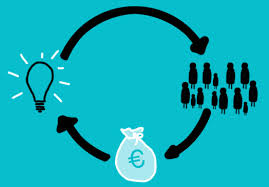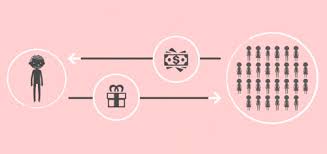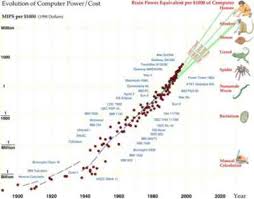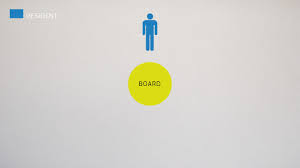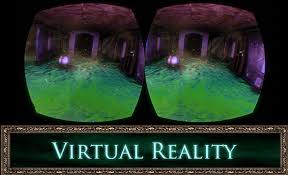Crowd Sourcing & Crowd Funding
•Crowdsourcing is the process of getting work or funding, usually online, from a crowd of people. The word is a combination of the words ‘crowd’ and ‘outsourcing’. The idea is to take work and outsource it to a crowd of workers.
•Famous Example: Wikipedia : Instead of Wikipedia creating an encyclopedia on their own, hiring writers and editors, they gave a crowd the ability to create the information on their own.
•Quality: By canvassing a large crowd of people for ideas, skills, or participation, the quality of content and idea generation will be superior.
•Jeff Howe, editor of Wired magazine, first coined the term “crowdsourcing” in a June 2006 article.
•Possibly the earliest example of crowdsourcing is the collection of words for the Oxford English Dictionary. In 1858, a group called the Philological Society contracted with over 800 volunteer readers to collect words from all available books and document their usages. Subsequently, the group solicited broader public input and received over six million submissions over the 70 years of the project.
Strong Spots
•Crowdsourcing increases the productivity of a company while minimizing labor expenses. The Internet is a time-proven strategy for soliciting feedback from an active and passionate consumer base.
•Companies utilize crowdsourcing not only in a research and development capacity, but also for marketing, creating content and giving feedback.
Weak Spots
•Crowds are not employees, so executives can’t expect to control them. They will demand time, attention, patience, good listening skills, transparency, and honesty.
•It is unlike working in traditional style.
Different Types of Crowdsourcing
Crowdsource Design
•If you’re looking for a logo design, you can tell a crowd of designers what you want, how much you will pay, and your deadline. All interested designers will create a finished design specifically for you.
Crowdsourcing can also be used to get designs for furniture, fashion, advertisements, video, & product design.
Microtasks
•Micro tasking involves breaking work up into tiny tasks and sending the work to a crowd of people. If you have 1,000 photos on your website that need captions, you can ask 1,000 individual people to each add a caption to one photo. Break up the work and decide the payment for each completed task.Work is done faster, cheaper, and usually with less Innovation.
Open Innovation
•Open innovation allows people from all aspects of business such as investors, designers, inventors, and marketers to collaborate into a functional profit making reality. This can be done either through a dedicated web platform to gain outside perspective, or used with only internal employees.
•Open innovation brings together people from different parts of the world and different sectors of business to work together on a project.
Crowd Funding
•Crowdfunding is asking a crowd of people to donate a defined amount of money for a specific cause or project in exchange for various rewards.
There are three general categories :
•Equity-based is asking a crowd to donate to your business or project in exchange for equity.
•Donation-based is asking a crowd to donate to your project in exchange for tangible, non-monetary rewards such as an ecard, t-shirt, pre-released CD, or the finished product.
•Debt-based is asking a crowd to donate to your business or business project in exchange for financial return and/or interest at a future date.
•There are numerous crowdfunding platforms where consumers can safely ask for or donate money such as Kickstarter, Indiegogo, RocketHub.
•Project creators can create a profile typically containing a short video, an introduction to their project, a list of rewards per donation, and some images to elaborate.
•Each campaign is set for a goal amount of money and a fixed number of days. Once the project is launched, each day will be counted down and the money raised will be tallied up for visitors to follow its success.
•Instead of traditional investors, crowdfunding campaigns are funded by the general public. Typically, most successful projects receive about 25-40% of their revenue from their first, second and third degree of connections. This could include friends, family, work acquaintances, or anyone that the owner is connected to, including their second and third degree connections. Once a project has seen some traction, unrelated consumers start coming out of the woodwork to support campaigns they believe in.
The Good
•Crowdfunding is useful for a variety of opportunities, whether fundraising for disaster-relief, creative projects, creating a salable product, or creating a start-up.
•Crowdfunding platforms allow you to market your project, generate interest, and receive funds.
•Crowdfunding backers can provide useful feedback about your project.
The Bad
•Crowdfunding your project exposes your ideas to potential copycats.
•These platforms may limit the amount of funds you can receive.
•Crowdfunding regulations and taxation can be difficult to work with.
References : dailycrowdsource.com ; forbes
Technological Singularity
•The singularity marks a moment when technology trumps the human brain, and the limitations of the mind are surpassed by artificial intelligence.
•The Singularity is the hypothetical future creation of super intelligent machines. Super intelligence is defined as a technologically-created cognitive capacity far beyond that possible for humans.
•According to Singularity theory, super intelligence will be developed by self-directed computers and will increase exponentially rather than incrementally.
•The singularity comes after the time when our technological creations exceed the computing power of human brains. When there are intelligences capable of creating more intelligent beings in rapid succession, we enter an age where technological advances move at a rate we can’t even dream of right now.
•Proposed mechanisms for adding superintelligence to humans include brain-computer interfaces, biological alteration of the brain, artificial intelligence (AI) brain implants and genetic engineering.
•Futurists such as Ray Kurzweil (author of The Singularity is Near) have predicted that in a post-Singularity world, humans would typically live much of the time in virtual reality, which would be virtually indistinguishable from normal reality. Kurzweil predicts, based on mathematical calculations of exponential technological development, that the Singularity will come to pass by 2045.
•Science-fiction writer Vernor Vinge first used the term the Singularity in this context in the 1980s. It was also used by mathematician John von Neumann.
•With that superhuman intelligence and incredibly fast, powerful processing power, it’s not a stretch to imagine that software re-writing its own source code as it arrives at new conclusions and attempts to progressively improve itself.
•Futurists speculate that such advanced technology would enable us to improve the processing power, intelligence and accessible memory limits of our own minds through changing the structure of the brain, or ‘porting’ our minds on to the same hardware that these intelligences will run on.
•According to Kurzweil’s predictions, we will see computer systems as powerful as the human brain in 2020, artificial intelligence after 2029, the year in which Kurzweil predicts we will have reverse-engineered the brain. It’s that breakthrough that will allow us to create artificial intelligence, and begin to explore other ideas like that of mind uploading.
•Within a quarter century, non biological intelligence will match the range and subtlety of human intelligence. It will then soar past it because of the continuing acceleration of information-based technologies, as well as the ability of machines to instantly share their knowledge. Intelligent nano robots will be deeply integrated in our bodies, our brains, and our environment, overcoming pollution and poverty, providing vastly extended longevity, full-immersion virtual reality incorporating all of the senses, experience beaming, and vastly enhanced human intelligence. The result will be an intimate merger between the technology creating species and the technological evolutionary process it spawned.
•Non biological intelligence will have access to its own design and will be able to improve itself in an increasingly rapid redesign cycle. We’ll get to a point where technical progress will be so fast that unenhanced human intelligence will be unable to follow it. That will mark the Singularity.
•Many writers also tie the singularity to observations of exponential growth in various technologies (with Moore’s Law being the most prominent example), using such observations as a basis for predicting that the singularity is likely to happen sometime within the 21st century.
•The term “technological singularity” reflects the idea that such change may happen suddenly, and that it is difficult to predict how the resulting new world would operate. It is unclear whether an intelligence explosion of this kind would be beneficial or harmful, or even an existential threat.
Vinge predicted four ways the singularity could occur:
1)The development of computers that are “awake” and superhumanly intelligent.
2)Large computer networks (and their associated users) may “wake up” as a superhumanly intelligent entity.
3)Computer/human interfaces may become so intimate that users may reasonably be considered superhumanly intelligent.
4)Biological science may find ways to improve upon the natural human intellect.
References : whatis ; thenextweb
CoWorking
•Coworking is a business services provision model that involves individuals working independently or collaboratively in shared office space.
•Coworking is a style of work that involves a shared working environment, yet independent activity. Unlike the typical office environment, a coworking space is generally shared by individuals from different organizations and professions.
•The idea is simple: independent professionals and those with workplace flexibility work better together than they do alone.Coworking spaces are about community-building and sustainability.
•This style of work is attractive to creative types, entrepreneurs, independent contractors, work-at-home professionals, and people who travel frequently and end up working in relative isolation.
•Coworking also provides a social environment where individuals can work independently while still being part of a community of talented individuals with shared values and synergy.
•Working from home, has some cons.Sometimes it can feel isolating or distracting. Receiving all the business mail at home means one is giving his/her home address out to anyone who asks, and separating work from home life is a challenge.
•Some looking for a sense of community turn to working from coffee shops – which often means fighting for a table, begging someone for a plug, or being distracted by others.
•Coworking gives you a professional space where you can be more productive and potentially more prosperous. Another benefit is, it is inherently more economically sustainable, and shared resources means that it’s more eco-friendly.
•Coworkers can also take advantage of meeting and conference rooms to do conduct professional meetings and workshops.Finally Coworking allows members to network and connect with a like-minded group of people for ideas, feedback, and resources.
•Coworking offers a solution to the problem of isolation that many freelancers experience while working at home, while at the same time letting them escape the distractions of home.
Co-Working is for
•Individuals who enjoy working for themselves but not always by themselves.
•People who are looking for a sense of community and a focused place to work.
•The typical user of a coworking facility is self-employed, a telecommuter, or a freelance worker. Some businesses use the spaces to provide employees with equipment, space and services that they could not afford.
•Larger enterprises sometimes use coworking facilities to provide office space when they have more than the normal number of employees working at any given time.
Co-Working Space
Coworking space include:
•Shared work spaces.
•24/7 access.
•Reservable conference and board rooms.
•Wi-Fi.
•Communal printer/copier/fax.
•Shared kitchens, bathrooms and lounges.
•Other Amenities available at different co-working spaces range from free Wi-Fi and coffee to weekly seminars with high-profile guest speakers and shared staff members, such as receptionists.
•Coworking facilities follow various business models. Some facilities, for example, are cooperatively managed spaces run as non-profit organizations. Such organizations may charge members just enough to support operations.
•Other models include flat rate memberships and fee structures based on access for a single visit or a certain number of days per week, month or year.
•Co-Working spaces offer memberships ranging from a daily drop in pass to a monthly or yearly membership to make changes in the size of your team — or even a change in location — painless.
•Co-Working spaces are also a great place to get hired if you want to work at a startup.
•In 2005 Brad Neuberg used “Coworking” to describe a physical space which he originally called a “9 to 5 group”
•Brad was also one of the founders of Citizen Space, the first “Work Only” Coworking space.
Net Neutrality
•Network neutrality is the idea that your cellular, cable, or phone internet connection should treat all websites and services the same.
•At its core, net neutrality is about treating all content on the Internet equally. This means that big websites won’t be given preferential treatment in relation to any other website, no matter how small.
•The core principle of net neutrality is a simple one: that all traffic (data) traveling across the internet should be treated the same at each stage of the process.
•Law Professor Tim Wu first used the phrase “net neutrality” in a law review article.
•Net neutrality is the principle that data packets on the Internet should be moved impartially, without regard to content, destination or source.
•Net neutrality is sometimes referred to as the “First Amendment of the Internet.”
•In essence, it argues that no bit of information should be prioritized over another. This principle implies that an information network such as the internet is most efficient and useful to the public when it is less focused on a particular audience and instead attentive to multiple users.
•Net neutrality describes the idea that whoever provides you Internet access—should treat all of your Internet traffic, or packets of data, the same way.
• Many believe net neutrality to be primarily important as a preservation of current freedoms.
•Open internet:
The idea of an open Internet is the idea that the full resources of the Internet and means to operate on it are easily accessible to all individuals and companies. This often includes ideas such as net neutrality, open standards, transparency, lack of internet censorship, and low barriers to entry.
FCC
•In the United States, the U.S. agency responsible with upholding laws related to net neutrality is the Federal Communications Commission (FCC), which is based in Washington, D.C.
•The Federal Communications Commission (FCC) is currently debating legislation to define limits for internet service providers (ISPs).
•Although no country is in charge of regulating the Internet, the United States Federal Communications Commission (FCC) has considerable influence. In 2010, the FCC extended carrier network rules to Internet Service Providers (ISP), requiring them to offer fair and equal access to the Internet for all content, as long as the content is legal.
•Early in 2014, however, a Court of Appeals ruled that the FCC does not have the authority to extend carrier network rules to ISPs and people began to speculate about whether or not the FCC would use its power to reclassify Internet service as a telecommunications service.
•Proponents of this approach believed it was a simple solution that would give the FCC the power to legally enforce common carrier rules and therefore, Net neutrality.
•Obama announced that he was urging the FCC’s chairman, Tom Wheeler, to implement net neutrality rules by reclassifying ISPs as common carriers.
Paid Prioritization-Fast Lanes
•The term refers to ISPs charging third party companies for speedier access to those ISPs’ customers. So, say your ISP is XYZ, and you use both Ello and Facebook. If Facebook pays XYZ to “prioritize” its traffic, and Ello does not, you would likely experience faster speeds on Facebook: Its pages and apps would load more quickly, and more reliably, than Ello.
•This arrangement obviously incentives both Ello and Facebook to pay XYZ to prioritize their traffic.
•ISPs wouldn’t be allowed to slow down Internet traffic; but in exchange for higher payments from content providers, they might be able to speed it up.
Two-Tiered
•In a two-tiered model, carriers would be able to charge content providers a premium fee for priority placement and faster speed across their pipes.
•Critics of the two-tiered model believe that the extra costs incurred for premium service will be passed down to the consumer and that some type of legislation should be in place to protect the interests of the public.
•They point out that in a Net-neutral environment, small, independent sites are on an even playing field with large, corporately-owned sites and that is what has sparked innovation and economic growth.
References : gawker ; techtarget
Limited Liability Partnership
•A Limited Liability Partnership (LLP) is a partnership in which some or all partners (depending on the jurisdiction) have limited liabilities.
•It therefore exhibits elements of partnerships and corporations.
•In an LLP, one partner is not responsible or liable for another partner’s misconduct or negligence. This is an important difference from the traditional unlimited partnership.
•In an LLP, some partners have a form of limited liability similar to that of the shareholders of a corporation. However in some countries, an LLP must also have at least one thing called as a “general partner” with unlimited liability.
•The general partner(s) have full management and control of the partnership business but also accept full personal responsibility for partnership liabilities. Limited partners have no personal liability beyond their investment in the partnership interest.
•Limited partners cannot participate in the general management and daily operations of the partnership business without being considered general partners in the eyes of the law.
•The general partner can be either an individual or a corporation.
•One of the more common limited partnership situations involves a silent partner, where one or more limited partners provide financing for the venture and the general partners run the business.
•Another aspect of limited partnerships is that in some businesses, the limited partner (passive investor) may be subject to special tax liabilities that can offset the tax shelter advantage.
•An LLP also contains a different level of tax liability from that of a corporation.
•Limited liability partnerships are distinct from limited partnerships in some countries, which may allow all LLP partners to have limited liability, while a limited partnership may require at least one unlimited partner and allow others to assume the role of a passive and limited liability investor.
Jurisdiction Variations
US
•In the United States, each individual state has its own law governing their formation. Limited liability partnerships emerged in the early 1990s, while only two states allowed LLP in 1992, over forty had adopted LLP statutes by the time LLPs were added to the Uniform Partnership Act in 1996.
•Some US states have combined the LP and LLP forms to create limited liability limited partnerships.
Limited Liability Limited Partnership (LLLP)
•The limited liability limited partnership (LLLP) is a relatively new modification of the limited partnership, a form of business entity recognized under U.S. commercial law.
•An LLLP is a limited partnership and as such consists of one or more general partners and one or more limited partners. The general partners manage the LLLP, while typically the limited partners only have a financial interest.
China
•In China, the LLP is known as a Special general partnership . The organizational form is restricted to knowledge based professions and technical service industries.
India
•The Limited Liability Partnership Act 2008 was published in the official Gazette of India on January 9, 2009 and has been notified with effect from 31 March 2009.
Japan
•Limited liability partnerships were introduced to Japan in 2006 during a large-scale revamp of the country’s laws governing business organizations.
UK
•A UK limited liability partnership is a corporate body – that is to say, it has a continuing legal existence independent of its members, as compared to a Partnership which may have a legal existence dependent upon its membership.
Advantages
•Renowned and accepted form of business worldwide in comparison to Company.
•Low cost of Formation.
•Easy to establish & manage
•No requirement of any minimum capital contribution.
•No restrictions as to maximum number of partners.
•No exposure to personal assets of the partners except in case of fraud.
•Easy to dissolve.
Disadvantages
•Any act of the partner without the other partner, may bind the LLP.
•Under some cases, liability may extend to personal assets of partners.
•Cannot raise money from Public.
Invisibility Cloaks
• Perhaps inspired by Harry Potter’s invisibility cloak, scientists have recently developed several ways,some simple and some involving new technologies to hide objects from view.
•There’ve been many high tech approaches to cloaking and the basic idea behind these is to take light and have it pass around something as if it isn’t there, often using high-tech or exotic materials.
•Many cloaking designs work fine when you look at an object straight on, but if you move your viewpoint even a little, the object becomes visible.
•Cloaking devices can also cause the background to shift drastically, making it obvious that the cloaking device is present.
•The first examples only worked with long wavelength radiation such as microwaves.
•To achieve the feat of cloaking an object, scientists have developed what are known as metamaterials, some of which can bend electromagnetic radiation, such as light, around an object, giving the appearance that it isn’t there at all.
Metamaterials
•Such invisibility cloaks rely on metamaterials, which are a class of material engineered to produce properties that don’t occur naturally.
•Light is electromagnetic radiation, made up of perpendicular vibrations of electric and magnetic fields. Natural materials usually only affect the electric component.But metamaterials can affect the magnetic component too, expanding the range of interactions that are possible.
•The metamaterials used in attempts to make invisibility cloaks are made up of a lattice with the spacing between elements less than the wavelength of the light.
Superlens
•Another use for metamaterials, potentially with greater scientific applications, is in building a superlens.
•A metamaterial with a negative refractive index might get around problems such as wave decay and allow imaging of objects only nanometers in size.
•Among the first practical applications would likely be using metamaterial lenses to view live viruses and maybe even bits of DNA.
The Rochester Cloak
•The latest effort, developed at the University of Rochester, not only overcomes some of the limitations of previous devices, but it uses inexpensive, readily available materials in a novel configuration.
•In order to both cloak an object and leave the background undisturbed, the researchers determined the lens type and power needed, as well as the precise distance to separate the four lenses.
•The Rochester Cloak can be scaled up as large as the size of the lenses, allowing fairly large objects to be cloaked. And, unlike some other devices, it’s broadband so it works for the whole visible spectrum of light, rather than only for specific frequencies.
•This cloak bends light and sends it through the center of the device, so the on-axis region cannot be blocked or cloaked.
Video : The Rochester Cloak
Applications
•Using cloaking to effectively let a surgeon look through his hands to what he is actually operating on.
•The same principles could be applied to a truck to allow drivers to see through blind spots on their vehicles.
•It can be used for surgery, in the military, in interior design, art etc.
References : physics.org ; phys.org
One Person Company
•An One Person Company (OPC) is a hybrid structure, wherein it combines most of the benefits of a sole proprietorship and a company form of business.
•One person company, only 1 person is required who can be a shareholder as well as the Director. Hence the name, One Person Company.
•OPC is a new concept in India which has been introduced by the companies act 2013. Though the concept of OPC is new in India but it is a very successful form of business in UK and several European countries since a very long time now.
•This concept of OPC was first recommended by the expert committee of Dr. JJ Irani in 2005.
•The words ‘One Person Company’ will have to be mentioned in brackets below the name of such company, wherever its name is printed, engraved or affixed.
Sole proprietorship v/s One Person Company
•The biggest difference between a sole proprietor and a One Person Company would be that in case of a One Person Company, your liability in case the business fails, is limited to only the business assets.
•In case of a proprietorship, the liability is unlimited and the creditors of your business can even take hold of your home and personal assets like your house, personal bank accounts etc which can be used to settle the business liabilities.
•Owing to the feature of it having a separate legal entity from its owners, the OPC is taxed separately, unlike a sole proprietorship.
Concepts of OPC
1. One share holder:
•This is the fundamental concept of a One Person Company.A single shareholder holds 100 percent shareholding.
•Further the rules also specify that a person can be a shareholder in only one one person company at any given time. It simply means an individual cannot have two different one person companies in his name.
2. One Director:
•The other important point is that a One Person Company may have only one director. But at the same time there is no bar on more number of directors. However, as per the Act, the total number of directors shall not be more than 15.
•The sole member is deemed to be the first director.
3. Nominee
•This is a very important concept where the person forming the One Person Company has to nominate a Nominee with his written consent who, in the event of death or inability to contract of the owner of the One Person Company, shall come forward and take over the reins of the one person company.
•On the death of the sole member, the nominee shall be the person recognized by the company as having title to all the shares of the member. Such nominee shall be entitled to the same dividends and other rights and liabilities to which such sole member of the company was entitled or liable.
4. Freedom from compliance
•One Person Company also gets freedom from complying with many requirements as normally applicable to other private limited Companies.
5. No requirement to hold annual or extra ordinary general meetings.
6. No requirement of preparing cash Flow in the annual financial statements
7. Annual returns can be signed by the Director himself instead of A Company Secretary.
Conversion from OPC to Private Limited Company
•It is provided in the Act that when a One Person Company reaches a paid up Capital of 5 million or more or when the average turnover of the company which is 20 million or more for a period of 3 years, then the company shall be converted into a private limited company after making the necessary changes in the memorandum of association and articles of association and shall comply with all the requirements of a private limited company.
Conversion from Private Limited Company to OPC
•A private limited company which does not have a paid up capital of more than 5 million or where the average annual turnover for the past 3 years is less than 20 million can convert itself into a One Person Company.
Virtual Reality
•Virtual reality is an artificial environment that is created with software and presented to the user in such a way that the user suspends belief and accepts it as a real environment.
•Virtual reality can be defined as an upcoming technology that makes users feel in a Virtual Environment (VE).
•To “enter” a virtual reality, a user dons special gloves, earphones, and goggles, all of which receive their input from the computer system. In this way, at least three of the five senses are controlled by the computer. In addition to feeding sensory input to the user, the devices also monitor the user’s actions.
•The goggles, for example, track how the eyes move and respond accordingly by sending new video input.
•That person becomes part of this virtual world or is immersed within this environment and whilst there, is able to manipulate objects or perform a series of actions.
•Other terms for virtual reality include cyberspace, artificial reality, augmented reality and telepresence.
Components of a VE:
•The visual displays that immerse the user in the virtual world and block out contradictory sensory impressions from the real world.
•The graphics rendering system that generates the ever changing images at 20 to 30 frames per second.
•A tracking system that continuously informs the position and orientation of the user’s movements.
VR experience in general it should include:
•3d images that appear to be life sized from the perspective of the user.
•The ability to track a user’s motions, particularly his head and eye movements, and correspondingly adjust the images on the user’s display to reflect the change in perspective.
Latency
•Lag time between when a user acts and when the virtual environment reflects that action is called latency.
•Latency usually refers to the delay between the time a user turns his head or moves his eyes and the change in the point of view, though the term can also be used for a lag in other sensory outputs.
Techniques
•One of the technique used to create a virtual environment is projection based. The display images are projected on the multi screen spaces ranging from two to six screens.
•Both floor and ceiling uses a rear projection while the other four screens yield large surrounding views for both panning actions and looking down.
•Consequently objects inside the space could be walked around and virtual entreat to be touched.
•VE systems need a way to display images to a user. Many systems use HMDs, which are headsets that contain two monitors, one for each eye. The images create a stereoscopic effect, giving the illusion of depth.
•Other VE systems project images on the walls, floor and ceiling of a room and are called Cave Automatic Virtual Environments (CAVE).
•Tracking systems analyze the orientation of a user’s point of view so that the computer system sends the right images to the visual display.
Development
•Virtual Reality Modeling Language (VRML)- the earliest three dimensional modeling language for the Web.
•X3D – the language that replaced VRML as the standard for creating virtual environments in the Internet.
•Collaborative Design Activity (COLLADA) – a format used to allow file interchanges within three dimensional programs.
Applications
•Virtual reality games.
•Some architects create virtual models of their building plans so that people can walk through the structure before the foundation is even laid.
•Car companies have used VR technology to build virtual prototypes of new vehicles, testing them thoroughly before producing a single physical part.
•Virtual environments are used in training programs for the military, the space program and even medical students.
•Another medical use of VR technology is psychological therapy.They use virtual environments as a form of exposure therapy, where a patient is exposed under controlled conditions to stimuli that cause him distress.
References: engineersgarage ; howstuffworks
Smart Clothes
•The term “smart clothing” denotes the presence of embedded electronics in clothes.
•Smart clothes include conductive fabrics that can power microelectronic devices, superhydrophobic materials and synthetic fabrics that can conserve body heat and promote increased blood circulation.
•Smart clothing is of great interest to the world’s militaries, which often try to pack as much functionality as possible into a single soldier’s equipment.
•Other possible features of smart clothing include the ability to detect chemicals in the air, quickly harden on contact with a speeding bullet, change color or opacity, generate power from the wearer’s movement, record the wearer’s speech and activity.
•With conductive or optical sensors woven into T-shirts, shorts and underwear, smart clothes will be able to pick up a greater range of body signals, at much higher sensitivities, than rigid sensors.
•Early prototypes can measure heart rate through ECG sensors on a T-shirt or EEG sensors in a beanie hat can monitor brain activity.
•Tight clothes such as cycling shorts can also measure how hard muscles are working, and sensors on the chest can measure respiration rate, based on chest movements as the wearer breathes. They can also detect changes in body temperature and signs of stress such as sweating.
•Smart socks that can predict the onset of diabetic foot ulcers. The socks are made from fibers that contain plastic optical fibers. The fibers shine a light on the skin to measure how well blood is pumping through the capillaries, sluggish flow can be a sign of ulcers.
•Pyjamas embedded with sensors to detect breathing rate could also help people who suffer from sleep apnea, triggering an alarm if breathing is interrupted.
Applications
Motion Detecting Pants
•These smart pants work via a loom that helps sew the wires and fabric together. Sensors embedded in the fabric measure the speed, rotation and flexibility of the pants with every movement.
•Wireless signals are sent from the pants to a computer to display the activity.
Biosensor Underwear
•US scientists have developed durable biosensors that can be printed directly onto clothing, to allow continuous biomedical monitoring outside hospitals. The aim is to enable constant monitoring of blood pressure and heart rate.
Heart Sensing Bra
•The heart sensing bra uses electronic modules and silver coated electrodes to pick up a person’s heart rate and transmit the data to a watch worn on the wrist.
Smart Shoes
•Nike+ running shoes come with a sensor that tracks your run, then sends the data to your iPod. It even has its own social network and can automatically tweet and post a status report on Facebook.
References: newscientist ; readwrite











